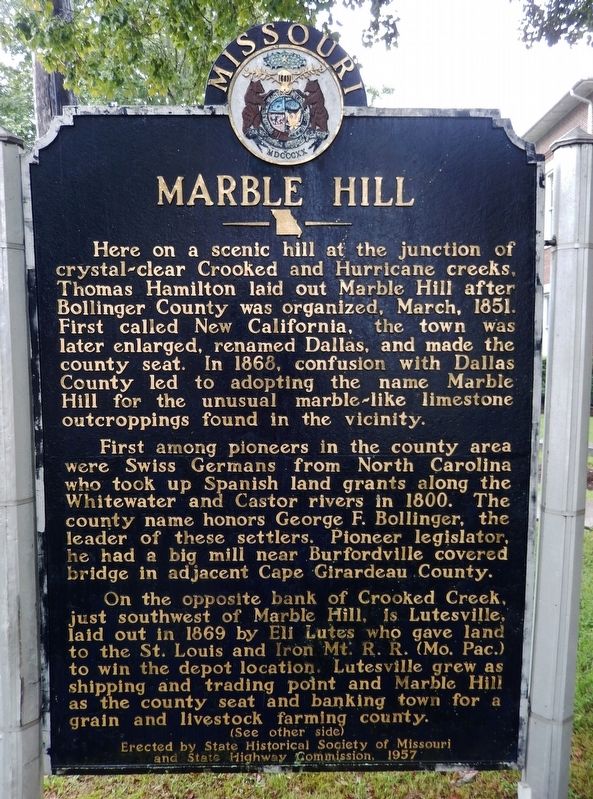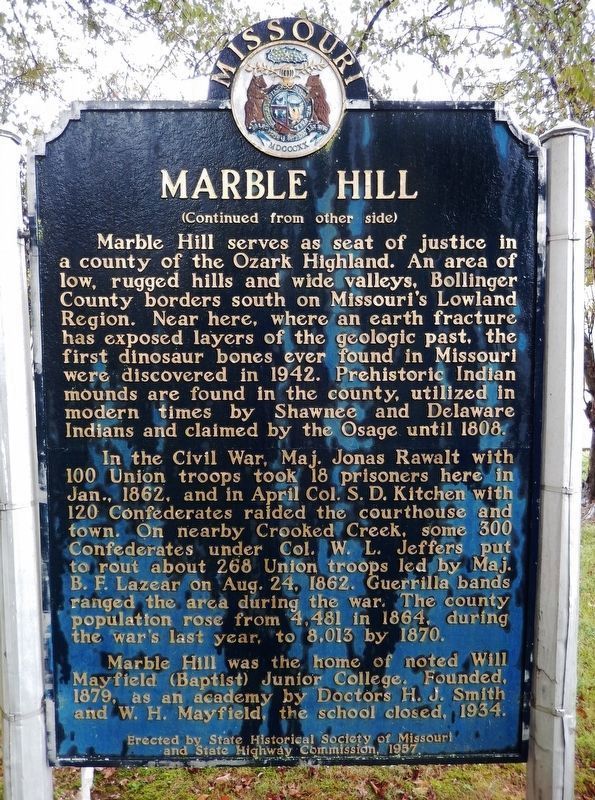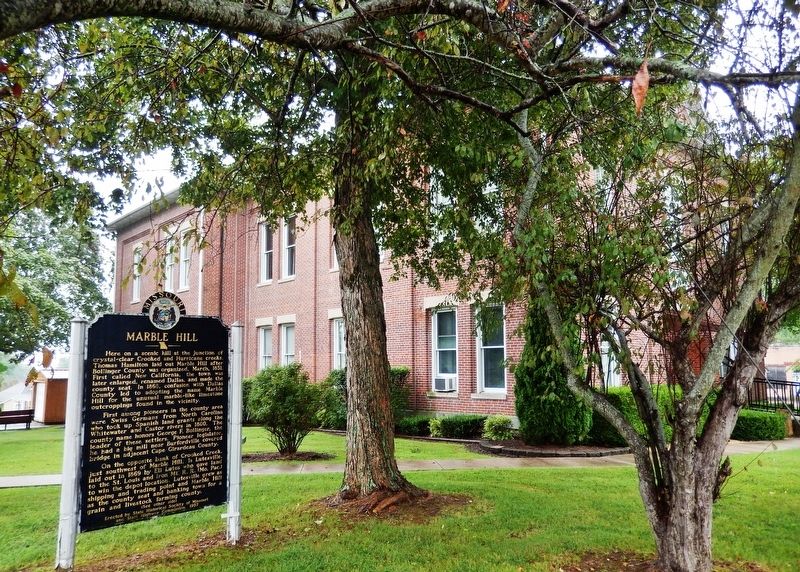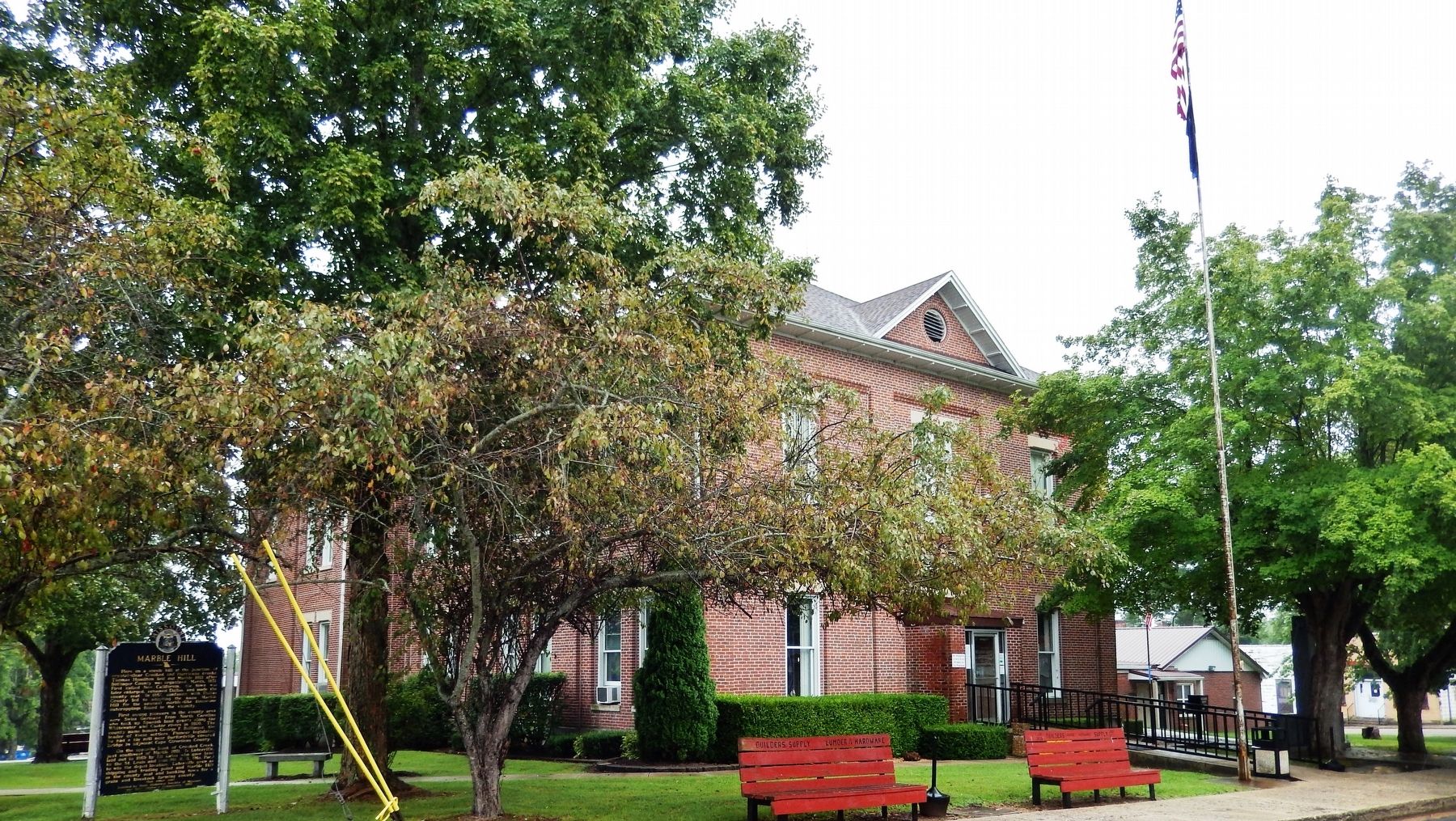Marble Hill in Bollinger County, Missouri — The American Midwest (Upper Plains)
Marble Hill
[side 1]
Here on a scenic hill at the junction of crystal clear Crooked and Hurricane Creeks, Thomas Hamilton laid out Marble Hill after Bollinger County was organized, March, 1851. First called New California, the town was later enlarged, renamed Dallas, and made the county seat. In 1868, confusion with Dallas County led to adopting the name Marble Hill for the unusual marble-like limestone outcroppings found in the vicinity.
First among pioneers in the county area were Swiss Germans from North Carolina who took up Spanish land grants along the Whitewater and Castor rivers in 1800. The county name honors George F. Bollinger, the leader of these settlers. Pioneer legislator, he had a big mill near Burfordville covered bridge in adjacent Cape Girardeau County.
On the opposite bank of Crooked Creek, just southwest of Marble Hill, is Lutesville, laid out in 1869 by Eli Lutes who gave land to the St. Louis and Iron Mt. R.R. (Mo. Pac.) to win the depot location. Lutesville grew as shipping and trading point and Marble Hill as the county seat and banking town for a grain and livestock farming county.
[side 2]
Marble Hill serves as a seat of justice in a county of the Ozark Highland. An area of low, rugged hills and wide valleys, Bollinger County borders south on Missouri's Lowland Region. Near here, where an earth fracture has exposed layers of the geologic past, the first dinosaur bones ever found in Missouri were discovered in 1942. Prehistoric Indian mounds are found in the county, utilized in modern times by Shawnee and Delaware Indians and claimed by the Osage until 1808.
In the Civil War, Maj. Jonas Rawalt with 100 Union troops took 18 prisoners here in Jan. 1862 and in April, Col. S. D. Kitchen with 120 Confederates raided the courthouse and town. On nearby Crooked Creek, some 300 Confederates under Col. W.L. Jeffers put to rout about 268 Union troops led by Maj. B.F. Lazear on Aug. 24, 1862. Guerrilla bands ranged the area during the war. The county population rose from 4,481 in 1864, during the war's last year, to 8,013 by 1870.
Marble Hill was the home of noted Will Mayfield (Baptist) Junior College. Founded, 1879, as an academy by Doctors H.J. Smith and W.H. Mayfield, the school closed, 1934.
Erected 1957 by State Historical Society of Missouri; and State Highway Commission.
Topics and series. This historical marker is listed in these topic lists: Native Americans • Paleontology • Settlements & Settlers • War, US Civil. In addition, it is included in the Missouri, The State Historical Society of series list. A significant historical month for this entry is March 1851.
Location.
37° 18.352′ N, 89° 58.193′ W. Marker is in Marble Hill, Missouri, in Bollinger County. Marker is at the intersection of High Street and Gilmore Street, on the right when traveling north on High Street. Marker is located at the northeast corner of the Bollinger County Courthouse grounds. Touch for map. Marker is at or near this postal address: 204 High Street, Marble Hill MO 63764, United States of America. Touch for directions.
Other nearby markers. At least 3 other markers are within 12 miles of this marker, measured as the crow flies. Mineral Well (within shouting distance of this marker); Bollinger Mill/Burfordville Covered Bridge (approx. 10.1 miles away); "Historical Marker" (approx. 11.9 miles away).
Also see . . .
1. Marble Hill, Missouri (Wikipedia). It was suggested in 1985 that the towns of Marble Hill and Lutesville should merge. Lutesville, which had been founded in 1869 and later became the main business and shipping center for the area, merged with Marble Hill and maintained the name of Marble Hill because it was the current county seat. The portion of Marble Hill that was the former city of Lutesville is the portion southwest of Crooked Creek. Crooked Creek has flooded the town on many occasions. (Submitted on August 21, 2021, by Cosmos Mariner of Cape Canaveral, Florida.)
2. Bollinger County, Missouri (Wikipedia). George
Frederick Bollinger persuaded 20 families to leave North Carolina in the fall of 1799 and settle in this region immediately west of what is now Cape Girardeau, Missouri. The Bollinger-led group of German Reformed families moved into the area in January 1800, crossing their wagons over the Mississippi River after an unusually cold stretch of weather had frozen the surface all the way across. Meanwhile, ownership of the region shifted in quick succession from Spain to France and then in 1803 to the United States via the Louisiana Purchase. (Submitted on August 21, 2021, by Cosmos Mariner of Cape Canaveral, Florida.)
Credits. This page was last revised on August 21, 2021. It was originally submitted on August 21, 2021, by Cosmos Mariner of Cape Canaveral, Florida. This page has been viewed 621 times since then and 82 times this year. Photos: 1, 2, 3, 4. submitted on August 21, 2021, by Cosmos Mariner of Cape Canaveral, Florida.



